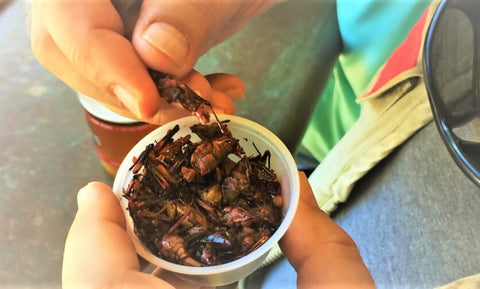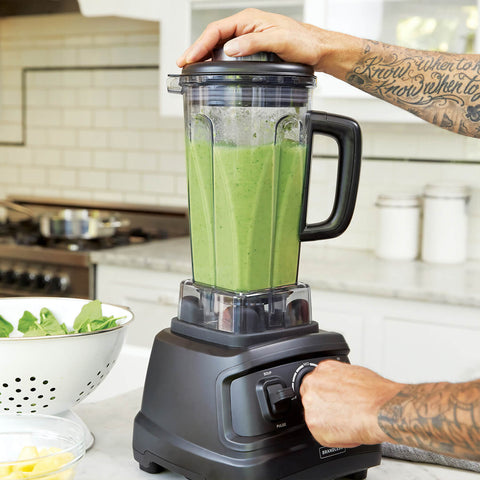What do Crickets Taste Like?
Crickets have a uniquely nutty, slightly smoky essence, with just a hint of astringency on the back of the palate. It’s a very pleasant umami flavor which with deepens with roasting.
Beyond that, crickets are delicious!
Though some say that crickets’ taste like chicken, after a lifetime of cooking I suspect that the generally neutral flavor of chicken (especially breast meat) often leads folks to describe any other unidentifiable neutral flavor the same way.
In other words, if we don’t know what it tastes like…it tastes like chicken!
So Now What...Eat More Crickets?
Yes! But also, spread the word.
In our daily quest to balance a hectic, always-on-the-go world with a socially responsible and healthy lifestyle, many of us are on a constant search for the Holy Grail of “quick, easy, and good for me.”
While a seemingly endless parade of supplements and shakes await us on the groaning shelves of local nutrition and grocery stores, chances are you - and most people - are missing out on the cricket; an all-natural, protein-packed snack available in a variety of ready-to-eat and tremendously tasty offerings.
While cable-network “survival reality” and gross-out gameshows go out of their way to sensationalize how “bizarre” it is to consume insects, and only for the most desperate situations, the truth is that television’s “reality” is (as usual) far from reality.
We sit in front of our TV’s thinking, “I guess if I had to, to survive, I could stomach one…”, but why eat crickets for any other reason? Well, few of us realize that entomophagy (the practice of eating insects) and especially crickets, have not only been a clean, healthy, and amazingly renewable source of protein for many, many cultures, including our own pre-Columbian societies, but they are also a delicious, celebrated, and much-loved nutrition-packed snack food, in countless parts of the world today.
What is the Environmental Impact of Raising Crickets for Food?
The mighty cricket contains, per ounce of powder, more than twice as much protein and amino acids as the same amount of beef, and significant amounts Omega 6, and dietary fiber which are nearly non-existent in beef.
Reaching adulthood in less than six weeks, crickets require 1/12th the amount of feed and 1/200th the amount of water (not even accounting for the watering requirements of fodder crops) to produce the same weight of edible protein as cows, with a nearly zero carbon footprint.
Not a naturally aggressive taste, cricket dishes are easily influenced by the ingredients and spices with which they are cooked, adding a meaty undertone to our favorite flavor combinations.
(My eight-year-old daughter says they taste like corn-nuts, only easier to eat.)
Do Crickets Taste Like Other Insects?
The taste of crickets is often compared to that of roasted or fried ants, but without the slightly bitter/burnt aftertaste. Insects, like all animals (and plants, for that matter) can vary in flavor, but there are certainly similarities within phylum, class, and orders.
True crickets share the same generally “nutty and roasted” characteristics with their cousins the bush cricket, katydids, locusts, and grasshoppers (all of the order orthoptera - meaning 'straight wings'), while other species like arachnids are typically noted as being reminiscent of crab or shellfish.
Should You Eat Crickets Raw? Roasted?
While commercially farmed crickets are perfectly safe to eat raw, wild crickets can be unpleasant and even parasitic, based on their food sources. It's actually part of the reason that crickets are still so expensive - a lot of effort is being put into making them exceptionally high quality.
That being said, many cultures from around the world have included this virtually unlimited protein source in their diets for unknown millennia, roasted crickets are generally preferred, given the act of roasting is generally considered to improve both the flavor and texture of most insects, including crickets.
The Biblical John the Baptist is noted in the Book of Matthew: “Now John himself wore clothing made of camel's hair, with a leather belt around his waist. His food was locusts and wild honey.” No mention is made as to whether he cooked them first or not. 😉
Author’s Note: Roasting is my preferred method, typically in a dry pan with Mexican (i.e. Chapulines) or S.E. Asian spices. Read more about how to cook crickets.
In What Other Forms Do Edible Crickets Come?
According to a HuffPost article titled, 5 Ways To Eat Crickets -- Yes, Crickets!:
“There's been quite a bit of buzz about eating our six-legged friends lately, in part because they're full of iron, protein, B12 and more. The New York Times reports research shows crickets even provide nearly as much calcium as milk.”
There are a number of cricket food products, and many ways to include cricket protein into our standard diets. Some of the most popular methods include:
So, the next time you’re looking for a fast, healthy, nutrition-packed snack to get you through the day, before you pop a pill, or shake a shake, do yourself (and the planet) a favor, and consider the mighty cricket!
(Camel hair poncho and wild honey optional…)




